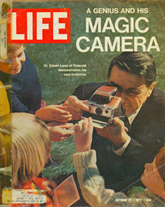| |
Land’s instant camera allowed someone to take a photograph, which then developed inside the camera in just 60 seconds. The revolutionary process was completely self-contained, made no mess, and did not require a trip to the store to get the film developed. This camera sold for $89.75, plus $1.75 for an eight-exposure package of film (which also held pods of developing chemicals for each image). People all over the world quickly embraced Land’s Polaroid cameras, making Polaroid Corporation one of the most successful companies of the 20th century.
Edwin Land, a visionary scientist, had founded Polaroid in 1937. The first product of the company, which had only a handful of employees at the time, was polarized sunglasses. During World War II, Edwin Land invented numerous products used by the United States Army. Polarized aviation goggles, stereoscopic rangefinders, aerial cameras, improved weapons sights, and anti-aircraft gun trainers were all created by Polaroid for use during the war. Edwin Land was an intelligence advisor for the Eisenhower, Kennedy, Johnson, and Nixon administrations of the 1950s and 1960s. During the 1950s, Land helped develop the U2 spy plane.

Edwin Land demonstrates his revolutionary SX-70 Polaroid Camera introduced in 1972. Life magazine thought his promotion of this new system of instant photography was so photogenic that they put it on the cover of the October 27, 1972 issue.
ID 97.54
|
By 1972, Edwin Land created an instant camera that achieved even greater popularity than the one introduced in 1948—the SX-70, the world’s first instant photography camera where the color film popped out the front of the camera and developed right before one’s eyes. It was a very sleek camera that could fold up and fit into a jacket pocket. Batteries came as part of the film pack, which was inserted into the front of the camera. The camera was then ready to take pictures—as quickly as every 1½ seconds. When the photograph was taken, a small motor inside the camera propelled the film out of the camera, unlike previous cameras where the owner had to manually pull the film out after waiting 60 seconds. It was by far Edwin Land’s masterpiece and his most famous invention. This camera originally sold for $180.00, plus $6.90 for a film pack. The SX-70 was so successful that the Polaroid Corporation was able to manufacture the camera on its own, including the film. For its earlier cameras, Polaroid had relied on other companies to make the film and batteries, but, for the SX-70, Polaroid built new factories to produce all the components and film. By 1976, over six million SX-70s were being sold a year. Polaroid camera owners were also snapping up film packs to use in the cameras—165 million that same year.
By the time that Edwin Land died in 1991 at the age of 81, he had created a company that at its height employed more than 20,000 people worldwide. Land had been issued 535 patents, second only to Thomas A. Edison in number. Edwin Land had revolutionized the photography industry, bringing easy, reliable, and affordable cameras to millions of people around the world. For the first time, people were able to capture a moment in time and view it instantly.
Instant photography—which was once revolutionary—has now become everyday. Digital cameras show us the fruits of our photographic endeavors right after we snap the picture—though they don’t yet produce an instant printed image like Edwin Land’s Polaroid cameras.
-- Zachary J. Waske, Intern

Polaroid instant photography cameras proved to be immensely popular. These snapshots were made with a variety of Polaroid cameras from 1958 through about 1986.

|

